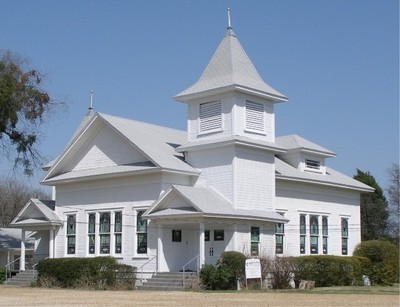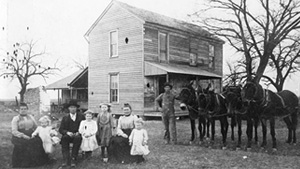
Wheatland United Methodist Church is known as the “oldest Methodist church west of the Trinity River”. Originally it resided in the small farming community of Wheatland. The Wheatland community may have been older than Dallas or Hord’s Ridge (the original name of Oak Cliff). With settlers arriving just before Texas entered the American Union, Wheatland may have been the first settlement in Dallas County (then a part of old Robertson County).
The Wheatland Methodist Church traces its roots back to 1838 when prayer meetings were held at the home of Reverend Thomas A. Crutchfield. Reverend Crutchfield was a veteran of Sam Houston’s army. The church was officially organized by Nacogdoches missionaries in the summer of 1847, and met in a one-room log cabin called “Wesley Chapel”. Wesley Chapel was located southeast of the intersection of Highway 67 and Camp Wisdom Road. At the time Wesley Chapel was built, or shortly after, the corners were marked by four Pecan trees. Those pecan trees still exist and are located in the back of Bankston Dodge near the corner of Marvin D. Love Freeway and St. George Drive.
In 1856, the Wesley Chapel was destroyed by a tornado which also devastated the town of Cedar Hill, eight miles to the south. Many people also died from yellow fever at about this same time. At Wesley Chapel it was believed that water from a nearby stream was contaminated because the stream lay at the foot of a slope below the Wesley cemetery. With the Wesley Chapel destroyed and to get away from the contaminated water, the Methodists moved to Wheatland and established a new church – which eventually became Wheatland Methodist Church.
At the time of the move Wheatland was known as “Sprowls’ Corner”, “Sprowls Store”, or just “Sprowls”, named after an early settler. When the U. S. Postal Service continued to confuse “Sprowls” with “Sowers”, another Dallas County community, the name became “Wheatland”. The land for the church building, as well as for a school, cemetery, and for the town of Wheatland itself, was donated by Tom Branson and H. K. Brotherton, partners in the real estate business.
The construction of the original Wheatland Methodist Church building was begun in 1856, by Jackson Bell, a pioneer builder, who was Sam Penn’s maternal grand-father. The foundation stones were hand-quarried limestone blocks from a local rock quarry. The lumber was hauled from Louisiana in ox-drawn wagons. The original lumber still supports the present structure.
In 1912, the need for expansion caused the congregation concern because of its policy to remain debt-free. However, Albert A. Rowe, a local builder, was asked to estimate the cost of a new structure. The $3,000 required, was contributed by ten members of the congregation, who gave $300 each. To the best of anyone’s knowledge, those ten were Charles Brotherton, T. B. Brixie, W. C. Davis, Charles S. Uhl, Lynn Brotherton, John Penn, Eph Bell, Will Rowe, Frank Tufts and Jess Spillers. (In later years, Eph Wilmut and William Bullock each contributed $300 towards reroofing this same structure.) With the entire cost of the new church building in hand, the construction began and was completed in the same year. As part payment for his services, Mr. Rowe stipulated that the new structure would have pictured glass windows like Dutch churches in his native state of Pennsylvania. The congregation agreed to this, and theirs was to be the first “country” church in this area to have pictured glass windows.
In the midst of the country’s depression, funds to support a church were hard to raise. Several times the church’s insurance lapsed. The women of the church took on the responsibility to make certain that this did not happen again. They gave socials and suppers, but soon found that they could not raise enough money for their purpose that way; so they began to quilt. Quilts were donated, quilted and sold, and their cause was amply supported. Once, when a pastor’s salary could not be met by regular church contributions, the ladies were challenged to make up the shortage with their quilting money; but they refused to give up any of their insurance fund.
Wheatland was annexed by Dallas in the mid 1950’s so it is now part of a large busy city. Except for a few renovations over the years, the church building remains much the same as it was when originally constructed. In fact, Wheatland United Methodist Church is now known as the “country church in the city”. In 1965, the Wheatland Methodist Church building was designated as a Texas historical landmark.
Submitted by Paul Foreman


